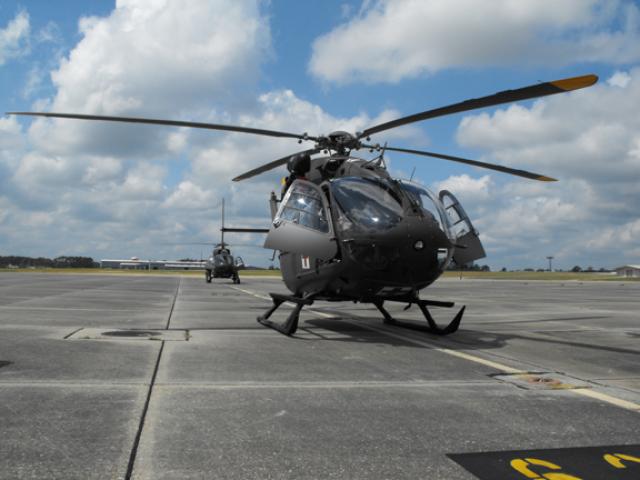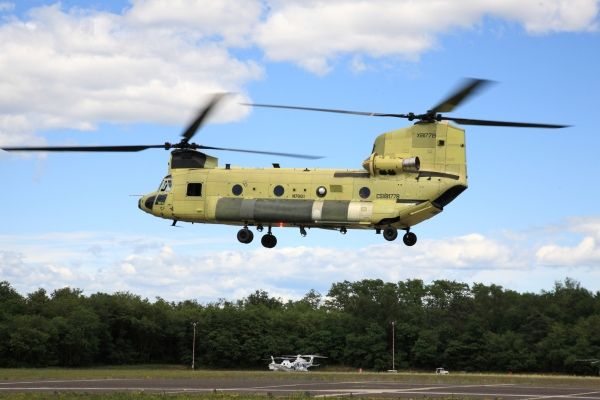The Army’s top aviation acquisition leader engaged industry members and community leaders on the future of Army aviation during an “Update for Industry” June 18 at The Summit.
Maj. Gen. Tim Crosby, program executive officer for aviation, spoke to members of the local chapter of the Association of the U.S. Army, where he emphasized balance, communication and shared resources, and ensuring that Army aviation maintains its relevancy with ground commanders.
“The reason our budget has been so stable for so long is that I’ve not needed to fight for it,” Crosby said. Nothing happens in the battlefield in Afghanistan without Army aviation, he said, whether it is to support Soldiers in combat, resupply, route clearance convoys, MEDEVAC support, or other missions.
“Our aviators out there today, working hand-in-hand with that ground commander, have established a rapport that has shown the value of Army aviation, and we must maintain that,” Crosby said.
Modernization efforts to support Operations Iraqi Freedom, New Dawn, and Enduring Freedom had increased the aviation acquisition budget to about $8 billion to support overseas contingency operations. “With our current budget climate, it is going to be difficult to maintain what we have,” Crosby said.
In order to remain relevant in the eyes of the ground commander, the Army must continue to train as it fights.
“We are their critical enablers in the battlefield, and we will break that bond if we don’t train together, and if we’re not able to support them at the level they need when they call on us,” Crosby said.
He said the Army’s natural tendency, with a declining budget, is to focus on individual training. “We have the best individual training in the world,” he said. But the Army does not do as well in collective training.
So what does this mean for the Army aviation community?
“We must find ways to reduce sustainment costs and to increase the efficiency with our training devices,” Crosby said. These include devices such as flight simulators that more realistically simulate flight training at the proficiency levels aviators need. “We can maintain proficiency with less flight hours, so that the flights hours that we do have, we could be doing the collective training with our brothers on the ground,” he said.
Other challenges, Crosby emphasized, are modernization programs that Army aviation needs to insert in a decreased budget climate.
“Every one of our aircraft is approaching 50 years old, or close to 50,” Crosby said. The CH-47 Chinook, OH-58 Kiowa Warrior, AH-64 Apache and UH-60 Black Hawk are the Army’s main aviation platforms. The only new aviation assets the Army is purchasing are unmanned aircraft systems.
“As we look to the future, we’re going to need some new system,” Crosby said. Citing the impressive Army aviation assets that supported Operations Desert Shield and Desert Storm, Crosby said, had someone not had the vision to see Army aviation’s future, the Army would have been fighting the Iraq war in the early 1990s with UH-1 Hueys and AH-1G Cobras.
“We have to look at the next technology. Identify what is that next capability, and we have to be willing to trade requirements,” he said.
Crosby emphasized that with today’s resource constraints, the Army must be willing to trade with what is available in technology, what is affordable, so that the acquisition community can “feed substantiated information” to the requirements leaders at Fort Rucker, and together, make equitable trades.
Because 75 percent of the aviation fleet is in utility and attack, the focus of the Future Vertical Lift will be to resource that combined variant in the FVL fleet. The FVL concept is to create a new rotorcraft that uses new technology, materials, and designs that are quicker, have further range, better payload, are more reliable, easier to maintain and operate, have lower operating costs and can reduce logistical footprints. “We want to increase the range, increase the payload, operate in high/hot, and increase our airspeed,” Crosby said.
In order to execute FVL and other modernization programs, the Army must understand that the requirements have to be tradable. “We have to understand and quantify, what is the cost of airspeed? And is the cost of that airspeed worth it?” Crosby said. “We have to consider all those trades and determine, what is the ‘best bang for our buck.'”
Crosby also discussed other modernization efforts such as the Improved Turbine Engine Program, which is being developed as the next generation engine for utility and attack helicopters. The ITEP will provide significantly increased operational capability, fuel efficiency, range and payload to meet Army mission requirements, including operations in high/hot environments, and lowers maintenance actions for the utility and attack variants of the Army’s helicopter fleet.
Combating Degraded Visual Environment in rotary wing aircraft does not pose as much of a challenge with newer platforms such as the UH-60M, AH-64E, and CH-47F, but it presents a big challenge with analog platforms, Crosby said. Digitized platforms are easier to improve upon because much of that is software development and software improvement.
One of PEO Aviation’s primary efforts is to modernize the UH-60L, taking existing airframes that have analog cockpits and updating them with digitized cockpits. The real goal, based on the Army’s requirements, is to make the L as similar to the M model as possible, so that when an aviator steps into an M model or an L model digital, he or she sees the same cockpit in terms of graphics and digitized capability. The pilot may not necessarily see the same box that displays the graphics, but it will look and operate exactly the same.
“We also need a new training helicopter. If we lose one in flight school, we can’t use that because we don’t build one anymore,” Crosby said.
The Army is also looking at replacing the C-12 fixed wing aircraft. “They have been flying around for the same amount of time as we’ve been flying Chinooks,” Crosby said. “We need to replace it with a Future Utility Aircraft.”
Injecting these modernization programs in a declining budget will be difficult, and Army aviation will have its share of challenges, he said.
The natural tendency, as the Army faces budget down turns, force structure changes, and sequestration, is for everyone to put their silos and guards up, he said.
Crosby challenged industry members to think strategically, to look at the long-term goals and the implications to government and industry if they don’t work together. His biggest concern, are the potential implications to the third and fourth tier vendors.
“The big industry leaders will survive this,” he said. “The third and fourth tier vendors will struggle much more.
“You are all leaders in industry. That’s why you’re here. I challenge you to knock those silos down. We need to lock arm-in-arm and understand each other’s challenges and work through it together.”
He gave the example of the recent signing of the CH-47F multi-year two production contract, which brought the American taxpayers more than $810 million in cost savings, and put stability in the industrial sector for the next five years. Success can be achieved when industry and government entities partner as one team to achieve quality and affordability goals.
“I believe we’ll all get through this if we work together,” Crosby said.
At the end of the breakfast, Kris McBride, newly inducted president for the local AUSA chapter, thanked Crosby for speaking with AUSA members and for answering all their questions. She presented him with a book titled “U.S. Army Aircraft Since 1947: An Illustrated Reference” that will be donated to the Post Library in Crosby’s honor.











